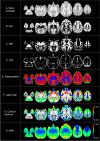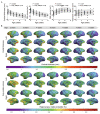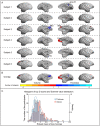Normative Analysis of Individual Brain Differences Based on a Population MRI-Based Atlas of Cynomolgus Macaques
- PMID: 32844170
- PMCID: PMC7727342
- DOI: 10.1093/cercor/bhaa229
Normative Analysis of Individual Brain Differences Based on a Population MRI-Based Atlas of Cynomolgus Macaques
Abstract
The developmental trajectory of the primate brain varies substantially with aging across subjects. However, this ubiquitous variability between individuals in brain structure is difficult to quantify and has thus essentially been ignored. Based on a large-scale structural magnetic resonance imaging dataset acquired from 162 cynomolgus macaques, we create a species-specific 3D template atlas of the macaque brain, and deploy normative modeling to characterize individual variations of cortical thickness (CT) and regional gray matter volume (GMV). We observed an overall decrease in total GMV and mean CT, and an increase in white matter volume from juvenile to early adult. Specifically, CT and regional GMV were greater in prefrontal and temporal cortices relative to early unimodal areas. Age-dependent trajectories of thickness and volume for each cortical region revealed an increase in the medial temporal lobe, and decreases in all other regions. A low percentage of highly individualized deviations of CT and GMV were identified (0.0021%, 0.0043%, respectively, P < 0.05, false discovery rate [FDR]-corrected). Our approach provides a natural framework to parse individual neuroanatomical differences for use as a reference standard in macaque brain research, potentially enabling inferences regarding the degree to which behavioral or symptomatic variables map onto brain structure in future disease studies.
Keywords: brain atlas; cortical thickness; cynomolgus macaque; individual differences; normative model.
© The Author(s) 2020. Published by Oxford University Press. All rights reserved. For permissions, please e-mail: journals.permission@oup.com.
Figures







Similar articles
-
Measures of brain morphology and infarction in the framingham heart study: establishing what is normal.Neurobiol Aging. 2005 Apr;26(4):491-510. doi: 10.1016/j.neurobiolaging.2004.05.004. Neurobiol Aging. 2005. PMID: 15653178
-
A 3D population-based brain atlas of the mouse lemur primate with examples of applications in aging studies and comparative anatomy.Neuroimage. 2019 Jan 15;185:85-95. doi: 10.1016/j.neuroimage.2018.10.010. Epub 2018 Oct 13. Neuroimage. 2019. PMID: 30326295
-
Individual variation in longitudinal postnatal development of the primate brain.Brain Struct Funct. 2019 Apr;224(3):1185-1201. doi: 10.1007/s00429-019-01829-5. Epub 2019 Jan 14. Brain Struct Funct. 2019. PMID: 30637493
-
Cortical and Subcortical Gray Matter Volume in Youths With Conduct Problems: A Meta-analysis.JAMA Psychiatry. 2016 Jan;73(1):64-72. doi: 10.1001/jamapsychiatry.2015.2423. JAMA Psychiatry. 2016. PMID: 26650724 Review.
-
Regional deficits in brain volume in schizophrenia: a meta-analysis of voxel-based morphometry studies.Am J Psychiatry. 2005 Dec;162(12):2233-45. doi: 10.1176/appi.ajp.162.12.2233. Am J Psychiatry. 2005. PMID: 16330585 Review.
Cited by
-
Population-Average Brain Templates and Application to Automated Voxel-Wise Analysis Pipelines for Cynomolgus Macaque.Neuroinformatics. 2022 Jul;20(3):613-626. doi: 10.1007/s12021-021-09545-4. Epub 2021 Sep 14. Neuroinformatics. 2022. PMID: 34523062
-
State-specific Regulation of Electrical Stimulation in the Intralaminar Thalamus of Macaque Monkeys: Network and Transcriptional Insights into Arousal.Adv Sci (Weinh). 2024 Sep;11(33):e2402718. doi: 10.1002/advs.202402718. Epub 2024 Jun 27. Adv Sci (Weinh). 2024. PMID: 38938001 Free PMC article.
-
Mapping brain-wide excitatory projectome of primate prefrontal cortex at submicron resolution and comparison with diffusion tractography.Elife. 2022 May 20;11:e72534. doi: 10.7554/eLife.72534. Elife. 2022. PMID: 35593765 Free PMC article.
-
Applying normative atlases in deep brain stimulation: a comprehensive review.Int J Surg. 2024 Dec 1;110(12):8037-8044. doi: 10.1097/JS9.0000000000002120. Int J Surg. 2024. PMID: 39806746 Free PMC article. Review.
-
Longitudinal mapping of the development of cortical thickness and surface area in rhesus macaques during the first three years.Proc Natl Acad Sci U S A. 2023 Aug 8;120(32):e2303313120. doi: 10.1073/pnas.2303313120. Epub 2023 Jul 31. Proc Natl Acad Sci U S A. 2023. PMID: 37523547 Free PMC article.
References
-
- Ball G, Seal ML. 2019. Individual variation in longitudinal postnatal development of the primate brain. Brain Struct Funct. 224:1185–1201. - PubMed
Publication types
MeSH terms
LinkOut - more resources
Full Text Sources
Medical

